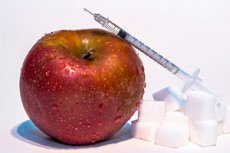Possible complications with insulin therapy
Last reviewed: 18.10.2021

All iLive content is medically reviewed or fact checked to ensure as much factual accuracy as possible.
We have strict sourcing guidelines and only link to reputable media sites, academic research institutions and, whenever possible, medically peer reviewed studies. Note that the numbers in parentheses ([1], [2], etc.) are clickable links to these studies.
If you feel that any of our content is inaccurate, out-of-date, or otherwise questionable, please select it and press Ctrl + Enter.

Non-compliance with the rules of insulin therapy leads to various complications. Consider the most common:
- Allergic reactions - most often occur at the injection site, but may manifest as generalized urticaria, anaphylactic shock. Their appearance is associated with a violation of injection equipment, the use of thick needles or their repeated use. A painful condition occurs when a too cold solution is injected or the site of the injection is incorrectly chosen. Also, the occurrence of allergies is facilitated by a break in treatment for several weeks or months. To prevent it after a break in treatment, you need to use only a human hormone.
- Hypoglycemia is a decrease in the concentration of sugar in the blood. This complication is accompanied by a characteristic symptomatology: profuse sweating, tremors of the extremities, palpitation, hunger. Hypoglycemia develops with drug overdose or with prolonged starvation. Complication can arise on the background of emotional experiences, stress, after physical overwork.
- Lipodystrophy - develops in places of frequent repeated injections. It leads to the disintegration of adipose tissue and formation of a seal (lipohypertrophy) or deepening (lipoatrophy) at the site of the lesion.
- Weight gain - this complication is associated with increased caloric intake and increased appetite due to hunger when stimulating insulin lipogenesis. As a rule, the gain in weight is 2-6 kg, but with all the rules of rational nutrition, this problem can be avoided.
- Visual disturbance is a temporary complication arising at the beginning of hormone administration. Vision is restored on its own in 2-3 weeks.
- The delay of sodium and water in the body - puffiness of the lower extremities, as well as increased arterial pressure associated with fluid retention in the body and have a temporary nature.
To reduce the risk of the above pathological conditions, it is necessary to carefully select the sites for injections and adhere to all the rules of insulin therapy.
Lipodystrophy in insulin therapies
One of the rare complications of insulin therapy, which occurs with prolonged and regular traumatization of small peripheral nerves and vessels with a needle, is lipodystrophy. The painful condition develops not only because of the administration of the drug, but also when using insufficiently pure solutions.
The danger of complication is that it disrupts the absorption of the injected hormone, causes painful sensations and cosmetic skin defects. There are such kinds of lipodystrophy:
- Lipoatrophy
Due to the disappearance of subcutaneous tissue at the injection site formed a fossa. Its appearance is associated with the immunological reaction of the body to poorly purified preparations of animal origin. Treatment of this problem consists of using small doses of injections in highly purified hormones along the periphery of the affected areas.
- Lipohypertrophy
It is the formation of infiltrates on the skin, that is, seals. It occurs when the technique of drug administration is violated, as well as after the anabolic local action of injections. It is characterized by a cosmetic defect and impaired absorption of the drug. To prevent this pathology should regularly change the injection site, and when using one area, leave the distance between the punctures of at least 1 cm. Physiotherapeutic procedures have phonophoresis with hydrocortisone ointment.
Prevention of lipodystrophy reduces to compliance with such rules: alternation of injection sites, the introduction of insulin heated to body temperature, slow and deep administration of the drug under the skin, use only sharp needles, careful treatment of the injection site with alcohol or other antiseptic.

